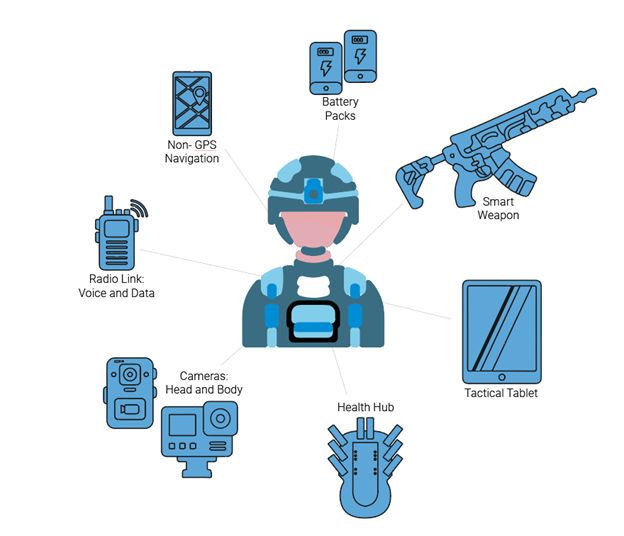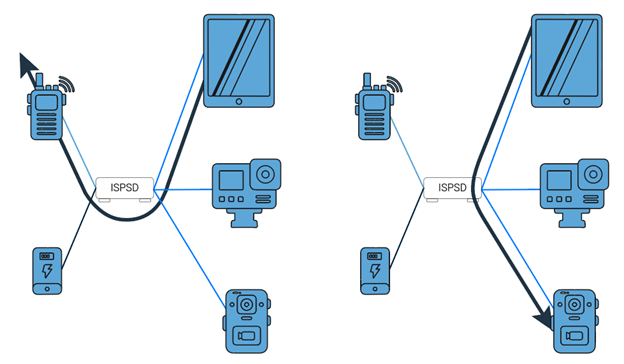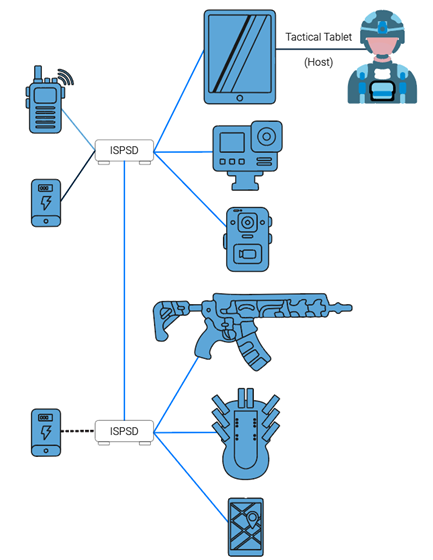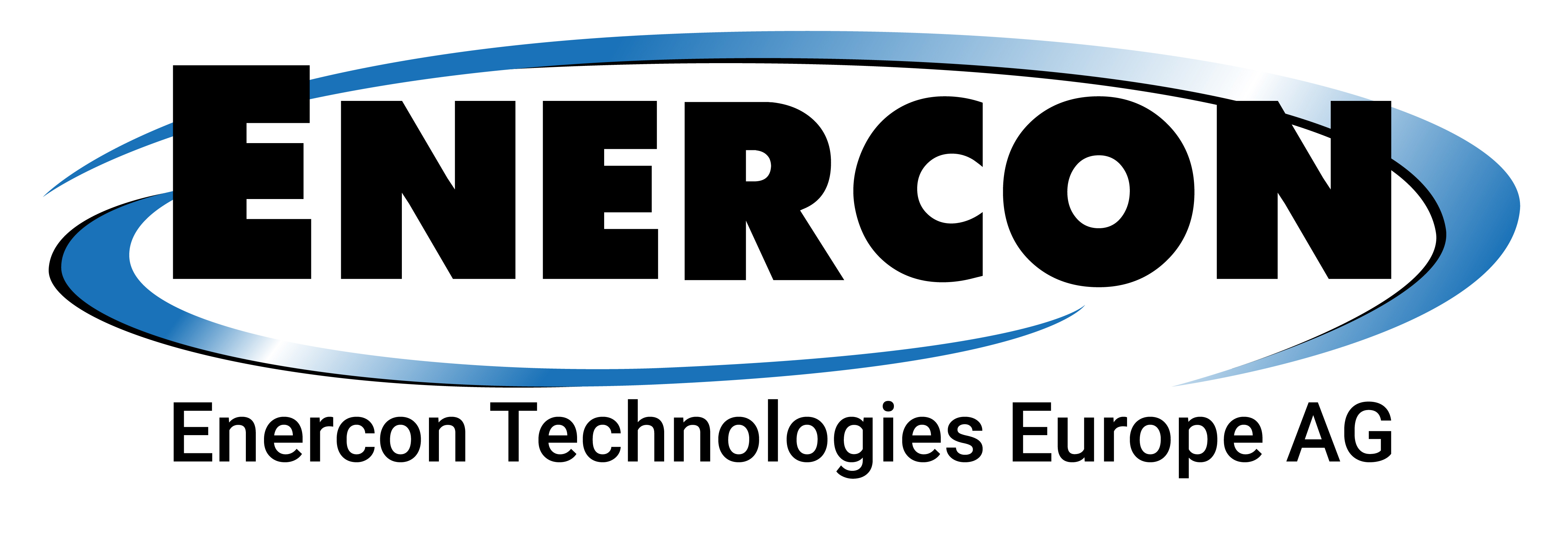In the theater of modern warfare, the image of the soldier has evolved dramatically. No longer merely combatants, today's soldiers are dynamic nodes in a vast information exchange network and strategic coordination.
The concept of the "connected soldier" has shifted from futuristic speculation to present-day reality, fundamentally altering the landscape of military operations. In this exploration, we delve into the intricacies of soldier wearables, networking solutions, and the seamless integration of advanced technologies, underscoring their pivotal role in enhancing operational effectiveness and ensuring mission success on the battlefield.

Multiple soldier devices, all sharing power and data resources.
From head to toe, the modern soldier is equipped with a suite of advanced gear optimized for performance, protection, and adaptability to diverse environmental conditions.
Portable communication devices enable real-time voice and data transmission, fostering seamless integration and connectivity across the battlefield.
Advanced helmets, featuring integrated heads-up displays (HUDs) and communication systems, serve as the nerve center of the soldier's equipment, facilitating seamless coordination with teammates and command centers.
Modular design allows for the integration of accessories such as night vision goggles and communication antennas, enhancing versatility in the field.
Handheld equipment, such as rifles and firearms, is equipped with advanced optics, laser aiming devices, and suppressors, enhancing accuracy and stealth capabilities.
Body armor, essential for safeguarding against ballistic and fragmentation threats, is augmented with integrated sensors capable of monitoring vital signs in real-time.
These sensors provide early warnings in case of injury, enabling timely intervention and ensuring the health and safety of military personnel.
Additionally, modular attachment points accommodate supplementary equipment such as ammunition and medical supplies, further enhancing the soldier's operational capabilities.
Moreover, environmental sensors provide insights into ambient conditions such as temperature, humidity, and chemical hazards, aiding in threat assessment and adaptation to changing battlefield environments.
Real-time monitoring of physiological parameters, including vital signs, hydration levels, and fatigue, enables timely intervention in case of health emergencies, ensuring the well-being of military personnel.
Clothing and Apparel
In terms of clothing and apparel, soldiers are outfitted with high-performance gear engineered for durability, comfort, and adaptability. Integrated cooling/heating systems regulate body temperature, while optimized camouflage patterns ensure effective concealment in various terrains.
Load-bearing equipment, including ergonomic vests and harnesses, facilitates the attachment of pouches and holsters, while power supply units enable the charging of electronic devices and equipment, ensuring continuous operation in the field.
The Evolution of Soldier Wearables
From the beginning of the smart soldier concept, it was clear that all types of devices (sensors and actuators) would need to rely on two elements: Power & Data. Any interruption in one of those, even for a fraction of time, will put the soldiers in danger and jeopardize the mission’s successful result.
Instead of having dedicated power and data links for each one of the devices, a shared approach was taken to save resources, complexity, weight, and cost.
The first generation of smart soldiers’ equipment started as two separate cores: one acting as a power hub and one acting as a data hub. This concept was relatively easy to implement but poses a few major cons: a higher number of components, double the amount of cabling, and non-coherent operation.
As a result, the second generation became much more integrated, and a new concept emerged: ISPDS – Integrated Soldiers Power & Data system. The ISPDS approach dramatically reduces the number of elements (hubs, cabling) and provides a single core to manage and monitor all elements of the smart and connected soldier.

First generation (left) vs second generation (right) of smart soldiers’ hubs.
Number and connection complexity dramatically reduced.
Although the domain is growing, there are several major challenges before making this vision into reality and have mass distribution in the field:
Managing and Sharing Power Resources
The limited energy carried by the dismounted soldier is minimal to save volume and weight yet should be sufficient to complete the mission. This poses few critical issues that need to be address, with the main goal to prolong the batteries life (longer field operational time when batteries supply is limited):
- Calculating mission time: evaluate the time remedies for full functionality and alert the soldier to charge / replace batteries.
- Optimizing multiple batteries scenario: Use smart logic in real time to prioritize multiple batteries discharge when operating in parallel.
- US DOD protocol (or equivalent): Enable host (tablet) device to monitor & control each parameter of the system to reduce energy usage.
- Independent devices supply: Failure in one device will not affect the rest of devices, remaining fully functioning.
Integral to the connected soldier concept are networking solutions designed to enable real-time data transmission and connectivity between soldiers and command centers, for voice and data communication in both directions.
Integrated communication systems, such as helmet-mounted displays, earpieces, and microphones, enable the exchange of critical information, enhancing situational awareness and decision-making capabilities on the battlefield.
To enable these two main communications lines, they need to be established.
For external communication, the radio device acts as a gateway (or a router) and enables devices to communicate with the external world and vice versa. The ISPDS core enable this communication as a “switch”
For internal communication, the ISPDS core acts as a switch, enabling the host device (Tablet) to communicate with each one of the devices, while the radio has no role.
The ability to support both internal and external communication is laid in the ISPDS core.

Communication examples: from tablet to the external world (left) and within the system (right)
In the military domain, there is not “one size fits all”. The needs change from one mission to another, and from one soldier to another. Yet having multiple types of ISDPS is not feasible in terms of logistics and operation.
To allow the scalability and versatility of ISPDS, the units need to support scaling by chaining multiple units.
For example, soldier A needs three USB ports and soldier B needs 6 USB ports. Both soldiers will use the same type of ISPDS, but soldier A will use one unit, while soldier B will use two units.

Example of chaining two ISPDS: The tactical tablet may access all connected devices,
regardless of physical ISPDS, and optionally prioritize the usage of secondary batteries.
Interoperability of Devices and ISPDS Core
As time passes, there are an increased number of soldier’s solutions, needing the same capabilities from the central power data hub.
All those devices need to work hand in hand to provide real value. Hence, the following aspects need to be considered:
Connectors: Ability to use standard connectors (such as NettWarrior) to eliminate misconnections.
Monitoring and control protocol: using standard US DOD (or equivalent) protocols to enable full control of devices (from cyber security to led brightness level)
Implementing Solutions: Enhancing Soldier Performance
In the pursuit of enhancing soldier performance, Enercon offers a comprehensive suite of battlefield power and networking solutions tailored to meet the demands of modern warfare.
Our ISPDS Smart Hubs serve as the backbone of soldier connectivity, seamlessly integrating data and power management functionalities into the current and future soldier suite.
Each product in the ISPDS family (MILTECH420, MILTECH410, MILTECH404 and many more) contains products with different combinations of features in the following domains:
Mission Time Management: Smart battery power allocation ensures efficient management of mission duration, enabling soldiers to operate effectively for extended periods without interruption using multiple batteries and combinations of power sources.
Soldier centric Data Connectivity: provide uninterrupted data connectivity across all wearable equipment, facilitating seamless communication between devices and host (tablet) using USB, Ethernet, and other communication protocols.
Soldier data hub Connectivity: Facilitating seamless connectivity to remote command and control centers, fellow soldiers, and drones, enabling efficient communication and data sharing among soldiers in the field.
Integrated data and Power: Simplified design, single unit providing power and communication to all wearable devices, reducing weight, volume, and abundant cabling.
Environmental Resilience: ISPDS are designed to withstand the toughest environmental conditions and meet stringent MIL-STD, 810, 461, and other standards.
Soldier centric design: our Smart Hubs prioritize Swap-C and intuitive interfaces yet ensuring reliable performance in the most demanding operational environments.
Looking ahead, as the landscape of modern warfare continues to evolve, the efficacy and reliability of soldier wearables and networking solutions remain paramount considerations for military applications.
By leveraging advanced technologies and innovative solutions, we can empower soldiers with the tools they need to succeed on the battlefield, ensuring mission success and the safety of personnel in dynamic and demanding environments.
Enercon's battlefield solutions redefine soldier connectivity and empower troops with advanced capabilities for mission success.

